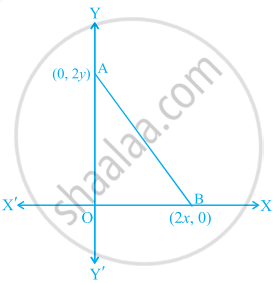Advertisements
Advertisements
Question
Show that the point (0, 9) is equidistant from the points (– 4, 1) and (4, 1)
Solution
Let P(x1, y1) = P(0, 9), Q(x2, y2) = Q(– 4, 1), R(x3, y3) = R(4, 1)
By distance formula,
d(P, Q) = `sqrt((x_2 - x_1)^2 + (y_2 - y_1)^2`
= `sqrt([(-4) - 0]^2 + (1 - 9)^2`
= `sqrt((-4)^2 + (-8)^2`
= `sqrt(16 + 64)`
= `sqrt(80)`
= `4sqrt(5)`
And
d(P, R) = `sqrt((x_3 - x_1)^2 + (y_3 - y_1)^2`
= `sqrt((4 - 0)^2 + (1 - 9)^2`
= `sqrt(4^2 + (-8)^2`
= `sqrt(16 + 64)`
= `sqrt(80)`
= `4sqrt(5)`
Here, d(P, Q) = d(P, R)
∴ The point (0, 9) is equidistant from (– 4, 1) and (4, 1).
RELATED QUESTIONS
The x-coordinate of a point P is twice its y-coordinate. If P is equidistant from Q(2, –5) and R(–3, 6), find the coordinates of P.
If the opposite vertices of a square are (1, – 1) and (3, 4), find the coordinates of the remaining angular points.
Find the distance between the following pairs of points:
(a, b), (−a, −b)
Name the type of quadrilateral formed, if any, by the following point, and give reasons for your answer:
(−3, 5), (3, 1), (0, 3), (−1, −4)
Find the distance between the following pair of points:
(-6, 7) and (-1, -5)
Show that the quadrilateral whose vertices are (2, −1), (3, 4) (−2, 3) and (−3,−2) is a rhombus.
Find the distance between the points
P(a + b,a - b)andQ(a -b,a + b)
AB and AC are the two chords of a circle whose radius is r. If p and q are
the distance of chord AB and CD, from the centre respectively and if
AB = 2AC then proove that 4q2 = p2 + 3r2.
Find the distance between the following pairs of point in the coordinate plane :
(13 , 7) and (4 , -5)
Find the relation between a and b if the point P(a ,b) is equidistant from A (6,-1) and B (5 , 8).
Prove that the points (a, b), (a + 3, b + 4), (a − 1, b + 7) and (a − 4, b + 3) are the vertices of a parallelogram.
PQR is an isosceles triangle . If two of its vertices are P (2 , 0) and Q (2 , 5) , find the coordinates of R if the length of each of the two equal sides is 3.
Find the distance between the origin and the point:
(8, -15)
Prove that the points A (1, -3), B (-3, 0) and C (4, 1) are the vertices of an isosceles right-angled triangle. Find the area of the triangle.
Calculate the distance between A (7, 3) and B on the x-axis whose abscissa is 11.
By using the distance formula prove that each of the following sets of points are the vertices of a right angled triangle.
(i) (6, 2), (3, -1) and (- 2, 4)
(ii) (-2, 2), (8, -2) and (-4, -3).
Show that P(– 2, 2), Q(2, 2) and R(2, 7) are vertices of a right angled triangle
The coordinates of the point which is equidistant from the three vertices of the ΔAOB as shown in the figure is ______.

The point A(2, 7) lies on the perpendicular bisector of line segment joining the points P(6, 5) and Q(0, – 4).
Find distance between points P(– 5, – 7) and Q(0, 3).
By distance formula,
PQ = `sqrt(square + (y_2 - y_1)^2`
= `sqrt(square + square)`
= `sqrt(square + square)`
= `sqrt(square + square)`
= `sqrt(125)`
= `5sqrt(5)`
